March 17, 2018
We started our last day in Villahermosa by seeing a few of the local sites of the city with our friends. One of the places they took us was the Mexico Villahermosa LDS Temple, built in 1999-2000. The LDS Church tries to draw from local architecture in designing temples, and that is certainly apparent here.
There were lots of church members milling about, including families (or maybe a youth group) having picnics.
We had to get in on the action ourselves!
Our friends needed to get ready for a meeting in another city, but we had time to share a meal before we said good-bye. They took us to a very unique place that served a unique dish. Does this look like a regular restaurant?
If I remember correctly, a family had modified their home to create a small restaurant with an outdoor kitchen . . .
It was served with some sides and sauces.
It can be made into a pretty scrumptious fish taco, or just eaten by itself.
There is no better way to say good-bye to friends than sharing a memorable final meal.
We had an afternoon to kill before catching our plane back to Mexico City, where we would spent a little more time before heading home, so our next stop was La Venta Park Museum.
The Olmecs were the first major civilization in Mexico and lived primarily in the present-day states of Veracruz and Tabasco (home to Villahermosa). Their civilization lasted from approximately 1500 BC to 400 BC.
The Olmecs are famous for their stone carvings. I think we tend to think of civilizations of this time period as very primitive, but I'm always so impressed by learning about them. For example, I can't begin to conceive how I would go about carving a heavy piece of rock into this statue without the use of any power tools (or even WITH power tools):
Carved sometime between 700 and 400 BC, this statue is called "The Grandmother." She looks like she has a mustache to me, but she also looks like she is holding a rolling pin. Or maybe it's a baby. Or maybe it's just a big rock she is going to use as a weapon if you laugh at her mustache.
My favorite of all the colossal heads is "La Venta Monument 1," which measures 7.9 feet tall and 6.8 feet wide and weighs 24 tons. It is the best-preserved head in the La Venta Park . . .
The La Venta Park also has a small, somewhat decrepit zoo. For the most part, Bob and I liked the wild animals roaming free more than the ones in the cages. Most fun of all were the dozens of coatimundis that wandered about, unperturbed by the invasion of two-footed creatures and actually willing to come quite close.
They walk with their tails perpendicular to their bodies, using them to signal each other.
Check out this snowy egret that looks like it dipped its feet in a can of gold paint. With feet like that, it's easy to spot. It had better be watching out for that croc.
We also stumbled across a McDonald's, which we usually don't eat at while traveling, but we often do go inside to check the menu for unique items. Nothing too unique here.
However, Bob fell for the "Que sea doble McNifica doble," which means something like "Make it double-double magnificent."
On a much larger scale, consider the enormous Olmec heads, mysterious rock carvings like those on Easter Island or Stonehenge. They were carved from basalt boulders brought here from the mountains near Veracruz, almost 100 miles away. No one has figured out how the Olmecs transported them. There are seventeen heads, the smallest weighing 6 tons and the largest weighing 40 to 50 tons. Three of the heads are in La Venta Park, and the others are in museums around the country. We had already seen two of the heads in the Museum of Anthropology in Mexico City.
The faces are all similar--flat noses, fleshy lips, and heavy brows. They look like many of the indigenous people who still live in this area today.
The head below is imaginatively titled "La Venta Monument 3." It is 6.5 feet tall and 5.2 feet wide. Although quite eroded, the features are still plainly visible. This head has been dated to between 1000 and 600 BC.
. . . and the one I clearly remember seeing during my visit in 1979. (The caption I wrote on this picture in my scrapbook is "Clearly I was missing Bob." We got engaged a few days after I got home from Mexico.)
Although less furry and bulky than their raccoon cousins, they have somewhat similar faces, black feet, and ringed tails.
In profile, however, that snout looks nothing like a raccoon but more like a pig!
It was extremely hot and humid, and we saw quite a few coatis taking the typical afternoon Mexican siesta.
Two years later we saw coatis near Iguazu Falls in Brazil. They were more gray than the rusty color we saw in Villahermosa, but equally unafraid of the tourists.
We didn't take very many photos of the caged animals, but we do have a few of this cute peccary:
And I took a video of the monkeys taking turns on the rope swing. Pay attention to the barking guy at the end.
I'm not sure if this gorgeous green iguana was captive or just freeloading off the other animals' food.
Just outside the park is a lazy river, and this croc was part of the scenery. Yikes.
Well, it doesn't take much to make us hungry, especially when we are traveling where there is such good street food. One of the things our friends told us to try in the La Venta Park area was elote, or Mexican corn on the cob.
There are two ways to eat it. For one version, the vendor cuts the corn off the cob, mixes it with butter, lime juice, and Mexican crema, and scoops the mixture into a cup, topping it off with crumbled cotija cheese and a little bit of chili powder for some heat because, you know, we weren't hot enough already.
The other way is to leave the corn on the cob, slather it with butter and crema . . .
. . . and then sprinkle it with a little bit of chili powder and roll it in cotija cheese.
Oh, yes. I definitely approve.
Have I mentioned how hot and humid it was? Only about a hundred times? Well, here is evidence. Every time Bob stepped outside, he had to deal with his glasses fogging up. He was very annoyed.
That's why our fans and treats like this were necessary.
We had just a little more time to kill before heading to the airport, so we walked around this market for a bit. The little red taxis reminded us of the tuk-tuks in Thailand and Sri Lanka, but nicer.
Or maybe it was this impressive condiment selection that sucked him in.
Later, we fell for these salted plantain chips at the airport--not something we usually see at airports in the United States, and we clearly hadn't eaten enough already that day. (And I didn't even include the big breakfast we ate.)
We could diet at home, right?





















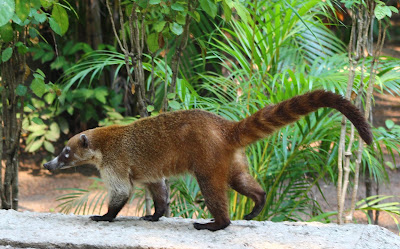








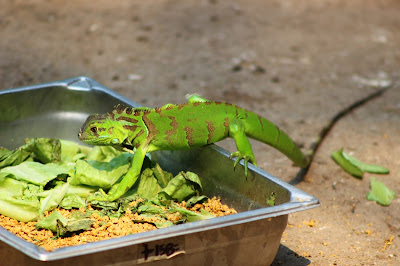



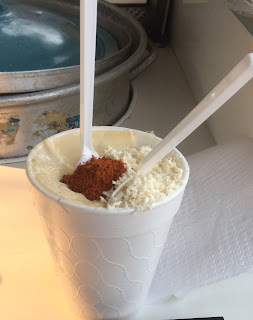
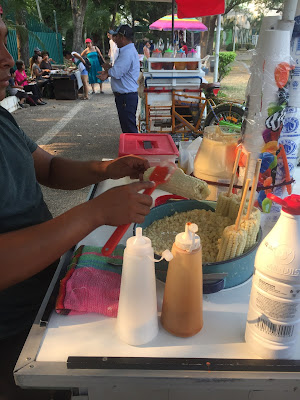
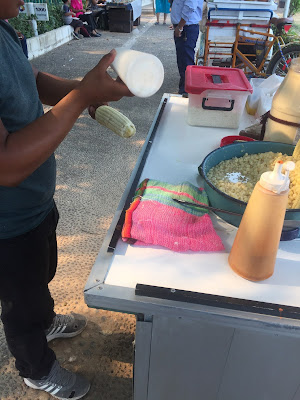










Looks like a lot of fun. I definitely need to get out to visit those Olmec heads.
ReplyDeleteI loved the coatis in La Venta and the zoo was actually pretty good. The growl of the jaguar was amazing. I love the doctored corn, looking at it got me salivating.
ReplyDelete